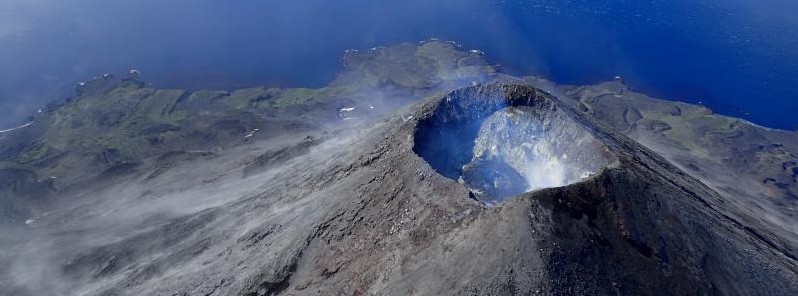Unrest at Cleveland volcano, Aviation Color Code raised to Orange

Unrest continues at Alaska's Cleveland volcano following a small explosion detected in seismic and infrasound data at 14:57 UTC on March 2, 2018
The event generated a small volcanic cloud that drifted to the ENE at an altitude of approximately 4.5 km (15 000 feet) above sea level.
Prior to yesterday's explosion, elevated surface temperatures were observed in satellite data several times over the past week (February 28, March 1 and March 2). Other than during yesterday's explosion, little activity has been observed in seismic and infrasound data over the past week.
Future explosive activity is likely, and may occur without warning, the Alaska Volcano Observatory (AVO) said. Previous explosions have produced hazardous conditions primarily near the summit crater, but occasionally they have been large enough to produce a drifting ash cloud.
Cleveland volcano is monitored with a limited real-time seismic network, which inhibits AVO's ability to detect precursory unrest that may lead to an explosive eruption. Rapid detection of an ash-producing eruption may be possible using a combination of seismic, infrasound, lightning, and satellite data.
Cleveland's most recent significant period of eruption began in February 2001 and produced 3 explosive events that generated ash clouds as high as 11.9 km (39 000 feet) above sea level. The 2001 eruption also produced a lava flow and hot avalanche that reached the sea.
Since then, Cleveland has been intermittently active producing small lava flows, often followed by explosions that generate small ash clouds generally below 6 km (20 000 feet) above sea level. These explosions also launch debris onto the slopes of the cone producing hot pyroclastic avalanches and lahars that sometimes reach the coastline.
Geological summary
Beautifully symmetrical Mount Cleveland stratovolcano is situated at the western end of the uninhabited, dumbbell-shaped Chuginadak Island. It lies SE across Carlisle Pass strait from Carlisle volcano and NE across Chuginadak Pass strait from Herbert volcano.
Cleveland is joined to the rest of Chuginadak Island by a low isthmus. The 1730-m-high (5 675 feet) Mount Cleveland is the highest of the Islands of the Four Mountains group and is one of the most active of the Aleutian Islands. The native name for Mount Cleveland, Chuginadak, refers to the Aleut goddess of fire, who was thought to reside on the volcano.
Numerous large lava flows descend the steep-sided flanks. It is possible that some 18th-to-19th century eruptions attributed to Carlisle should be ascribed to Cleveland (Miller et al., 1998).
In 1944 Cleveland produced the only known fatality from an Aleutian eruption. Recent eruptions have been characterized by short-lived explosive ash emissions, at times accompanied by lava fountaining and lava flows down the flanks. (GVP)
Featured image: Summit of Mt. Cleveland volcano – dome visible in crater – July 25, 2018. Credit: Cindy Werner, AVO/USGS

Commenting rules and guidelines
We value the thoughts and opinions of our readers and welcome healthy discussions on our website. In order to maintain a respectful and positive community, we ask that all commenters follow these rules:
We reserve the right to remove any comments that violate these rules. By commenting on our website, you agree to abide by these guidelines. Thank you for helping to create a positive and welcoming environment for all.